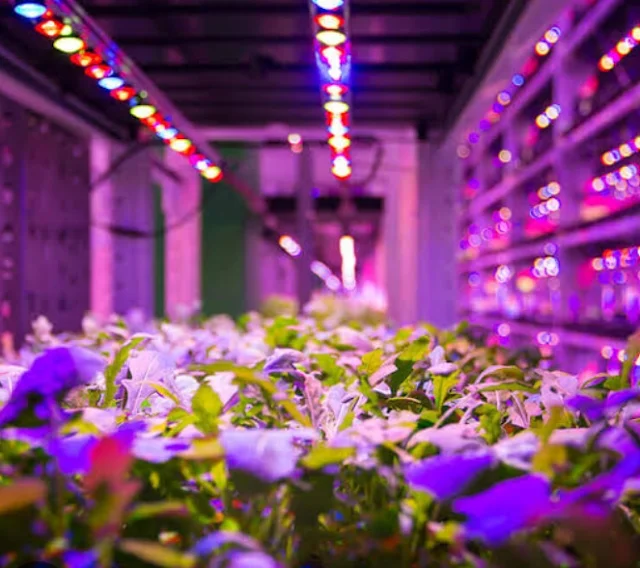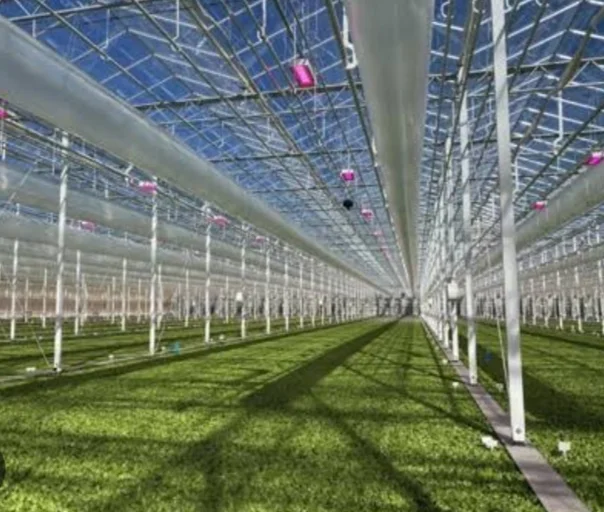Introduction Controlled-Environment Agriculture
Imagine a world where lush green fields sprout not in sprawling landscapes, but within the heart of bustling cities.
Where crops flourish independent of unpredictable weather patterns, producing bountiful yields year-round. This captivating vision is at the core of Controlled-Environment Agriculture (CEA), a revolutionary approach to food production that's reshaping the agricultural landscape.
What is CEA?
CEA is the practice of growing crops in environments where key factors like temperature, humidity, light, and nutrients are meticulously controlled.
This can take various forms, from high-tech, fully enclosed vertical farms stacked within urban centers to greenhouses harnessing natural sunlight. At its core, CEA leverages technology to optimize growing conditions, fostering a haven for plants to thrive regardless of external forces.
Controlled-Environment Agriculture (CEA): A Table Overview
Controlled-Environment Agriculture (CEA) refers to growing plants in a controlled environment, such as greenhouses or indoor vertical farms. This method allows for precise control of factors like temperature, humidity, lighting, and CO2 levels, optimizing plant growth and productivity.
| Aspect | Controlled-Environment Agriculture | Traditional Agriculture |
|---|---|---|
| Environment | Controlled indoor environment | Outdoor environment |
| Temperature | Precisely controlled | Varies with weather |
| Humidity | Carefully regulated | Varies with weather |
| Lighting | Artificial lighting | Sunlight |
| CO2 Levels | Controlled | Varies naturally |
| Nutrients | Precisely controlled | Varies with soil quality |
| Water | Controlled and recycled | Varies with rainfall and irrigation |
| Pests and Diseases | Minimized through controlled environment | Can be significant |
| Yield | Higher per unit area | Varies with weather and soil conditions |
| Location | Can be located anywhere | Limited to areas with suitable climate and soil |
Breaking Free from Tradition:
Gone are the days of being at the mercy of rain, drought, or pests. CEA systems create a protective bubble, eliminating the risks associated with traditional open-field agriculture. This translates to several benefits:
- Increased Yields: Precise control over growing conditions allows for maximized plant health and accelerated growth, leading to significantly higher yields compared to traditional farming.
- Year-Round Production: Crops are no longer bound by seasonal limitations. CEA enables continuous production, ensuring a steady supply of fresh, high-quality produce regardless of the time of year.
- Reduced environmental impact: CEA systems use considerably less water and land compared to conventional farming. Additionally, controlled environments minimize pesticide and fertilizer runoff, protecting nearby ecosystems.
- Sustainability at its core: By minimizing waste and optimizing resource utilization, CEA promotes a more sustainable food production system.
While CEA holds immense potential, challenges remain. High initial investment costs and energy consumption are key hurdles that need to be addressed for widespread adoption. However, advancements in technology and increasing awareness of the environmental benefits are driving rapid progress.
From vertical farms nestled within skyscrapers to innovative greenhouse designs, CEA is rapidly evolving. As research and development continue, we can expect to see even more efficient and sustainable systems emerge.
A Dive into the Diverse Types of Controlled-Environment Agriculture (CEA)
While imagining sprawling fields sprouting within cityscapes might seem futuristic, Controlled-Environment Agriculture (CEA) is rapidly turning this vision into reality. By meticulously controlling factors like temperature, humidity, light, and nutrients, CEA offers a spectrum of methods for cultivating crops that break free from the limitations of traditional farming.
Greenhouses: The classic CEA pioneers, greenhouses utilize natural sunlight within enclosed structures. Their benefits include protection from harsh weather, extended growing seasons, and pest control. However, dependence on sunlight restricts flexibility in location and year-round production.
Vertical Farming: Embracing urban spaces, vertical farming stacks growing beds or pods one atop the other within buildings or warehouses. This maximizes land use, minimizes transportation costs, and enables continuous production with artificial lighting and controlled environments.
Hydroponics: Ditching soil for nutrient-rich water solutions, hydroponics thrives in various settings from warehouses to shipping containers. It boasts rapid growth, efficient water usage, and precise nutrient control, but requires careful management of water quality and pH levels.
Aeroponics: Taking hydroponics a step further, aeroponics suspends plant roots in the air and mists them with nutrient-rich droplets. This maximizes oxygen and root development, but demands precise control of misting frequency and nutrient composition.
Aquaponics: Embracing sustainability, aquaponics combines plant cultivation with fish farming. Fish wastewater nourishes the plants, while the plants filter the water for the fish, creating a closed-loop system. This minimizes waste and conserves water, but requires expertise in managing both fish and plant needs.
Beyond the Usual Suspects:
The CEA landscape is constantly evolving. Controlled-environment growth chambers offer research and development platforms or sensitive crop production. Robotics and automation are streamlining tasks and increasing efficiency. Hybrid approaches like integrating vertical farming with greenhouses are also emerging.
Choosing the Right Tool for the Job:
Budget, space availability, desired crops, and climate considerations all play a role in selecting the optimal CEA system. Greenhouses offer a low-tech entry point, while vertical farming excels in urban settings. Hydroponics and aeroponics provide water efficiency but require expertise, while aquaponics promotes sustainability.
Controlled-Environment Agriculture (CEA) Technology
CEA Technology: Powering the Future of Food Production
Controlled-Environment Agriculture (CEA) isn't just about building fancy greenhouses – it's about harnessing a suite of advanced technologies to create the perfect growing conditions for plants, independent of the outside world.
Let's delve into the tech toolbox shaping the future of food production:
Environmental Control Systems:
- Climate Control: Advanced sensors and actuators monitor and adjust temperature, humidity, CO2 levels, and air circulation, mimicking ideal growing conditions for specific crops year-round.
- Artificial Lighting: LED technology mimics natural sunlight spectrums, optimizing photosynthesis and maximizing plant growth, even in urban settings.
- Nutrient Delivery Systems: Hydroponics, aeroponics, and aquaponics deliver precise nutrient solutions directly to plant roots, minimizing waste and maximizing efficiency.
Automation and Robotics:
- Automated Seeding and Transplanting: Robots handle delicate tasks like seed sowing and seedling transplanting, ensuring accuracy and reducing labor costs.
- Environmental Monitoring and Data Management: Sensors continuously collect data on plant health, nutrient levels, and environmental conditions, allowing for real-time adjustments and data-driven decision-making.
- Automated Harvesting and Sorting: Robotic arms equipped with vision technology can precisely harvest ripe produce, reducing handling damage and improving sorting efficiency.
Advanced Technologies:
- Biosensors and Imaging: Advanced sensors monitor plant health and stress levels, allowing for early detection of disease and proactive interventions.
- Vertical Farming Integration: Building automation systems integrate lighting, irrigation, and ventilation with building controls, optimizing efficiency and resource utilization.
- Data Analytics and AI: Machine learning algorithms analyze plant growth data and environmental conditions, predicting potential issues and suggesting optimal adjustments for maximized yields.
The benefits of CEA technology are numerous:
- Increased yields: Precise control over growing conditions optimizes plant growth, leading to significantly higher yields compared to traditional farming.
- Reduced environmental impact: Controlled environments minimize water use, fertilizer runoff, and pesticide use.
- Year-round production: Crops are no longer bound by seasons, ensuring a steady supply of fresh produce regardless of the weather.
- Improved quality and safety: Controlled environments minimize exposure to pests and diseases, leading to cleaner and safer food.
- Resource efficiency: Automated systems and closed-loop solutions like aquaponics minimize waste and optimize resource utilization.
Challenges remain:
- High initial investment costs: Setting up CEA systems can be expensive, requiring significant upfront investment in technology and infrastructure.
- Energy consumption: Artificial lighting and climate control systems can be energy-intensive, necessitating renewable energy sources for sustainable operation.
- Technical expertise: Operating and maintaining advanced CEA systems requires specialized knowledge and skills.
However, as technology advances and costs decrease, CEA is becoming increasingly accessible. The potential benefits for food security, sustainability, and resource efficiency are driving research and development, pushing the boundaries of what's possible.
From automated farm robots to AI-powered growth optimization, CEA technology is revolutionizing the way we grow food. With its focus on precision, efficiency, and sustainability, it offers a glimpse into a future where fresh, nutritious food is available to everyone, regardless of location or climate.
Future of Controlled-Environment Agriculture (CEA)
CEA holds immense potential for transforming food production. By optimizing growing conditions, minimizing environmental impact, and ensuring year-round production, it contributes to food security, sustainability, and improved access to fresh produce.
As technology advances and costs decrease, we can expect CEA to become increasingly integrated into the global food system, paving the way for a more resilient and sustainable future.
Whether you're a curious foodie or a potential CEA innovator, exploring this diverse world of controlled environments offers a glimpse into the exciting future of how we grow and consume food.
The future of agriculture is poised for a transformation, and CEA stands at the forefront. This pioneering technology offers a glimpse into a world where food security, sustainability, and resource efficiency come together, paving the way for a brighter future for generations to come.
CEA is not just a futuristic concept; it's a tangible reality with the power to revolutionize the way we grow and consume food. Let's embrace this transformation and cultivate a future where fresh, sustainable food is accessible to all.





